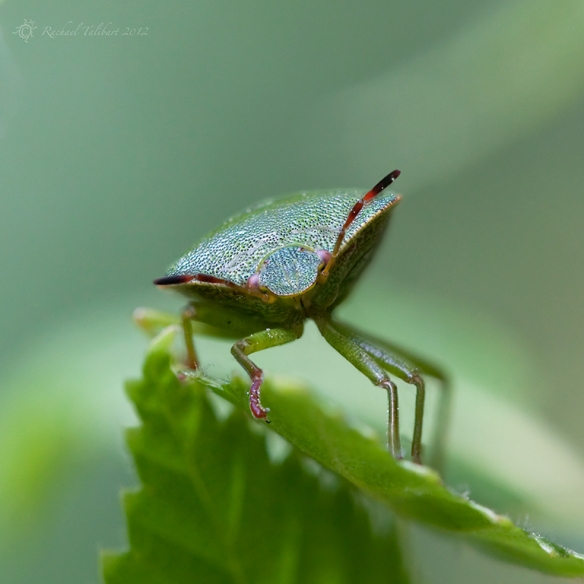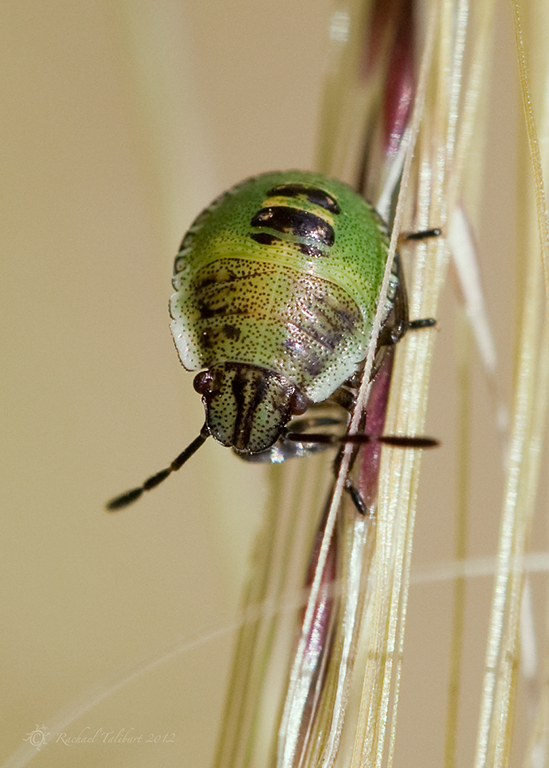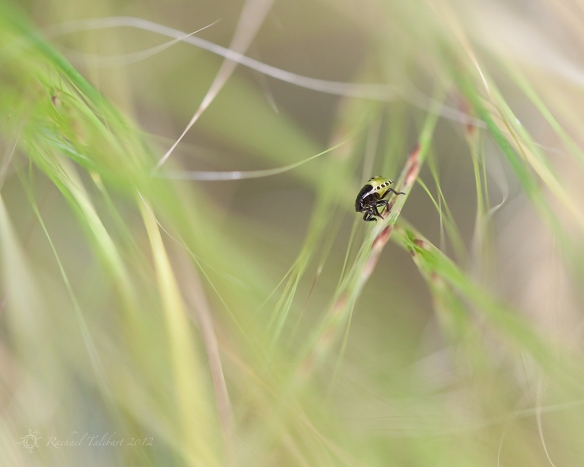This fine fellow is a common green shield bug. Shield bugs belong to the order hemiptera, whose members have a rostrum, or sucking beak, which they stick into plants. The common green is the most plentiful in my part of the world.
There are five nymph stages. I think the little ones are really quite cute.
There are several other varieties of shield bug that frequent our neighbourhood. I think this next one may be a hawthorn shield bug (acanthosoma haemorrhoidale).
But as green shield bugs change colour in the autumn, when this was taken, this one may just be another palomena prasina, teasing me.
So that’s the natural history done, now on to the art, which is what interests me most. The following is another version of the second instar shot.
I like this one better than the portrait crop I showed earlier. I like showing the instar as a small point within its (rather attractive in my opinion) grassy world. But a suggestion I often hear is that I crop closer with my bug shots. What do you think? All opinions very welcome.







Personally, I like both the simple portrait shots (cropped close) and shots showing the environment. (How’s that for sitting on the fence!) I would suggest get in close when the environment is not very attractive and do both close and distant when the environment is more attractive. Easy for me to say of course, I’m not the person down in the undergrowth. 🙂
Thanks. Undergrowth doesn’t bother me if I am on the trail of a good photo 😉
Here’s another fence-ridden opinion: both styles have much merit (especially when from your camera!), so what you’ve done here – showing both – is my preference. Fabulous, fabulous pictures.
Thank you, Sid. 🙂
I agree with the two previous comments. The spring adult sure looks MEAN, though! I wouldn’t want him sticking his rostrum in me!
He he. I think he looks slightly inebriated 😉
I’d definitely go for an instar’s world as it is not only a good photograph but you’ve managed to tell a story and ignite the imagination. The close-ups are amazing and interesting but focalised on the subject. I liked the natural history too! I’ve never noticed the instars.
Thanks. I do prefer the wider shots on the whole, but I am so often told to crop close that sometimes I begin to doubt myself!
What photogenic armor they wear! 🙂
He he. They are rather stylish. 🙂
I thought they must be related to the harlequin beetles common on our coastal cotton trees in Queensland, and it turns out they’re in the same order:
http://thegoatthatwrote.net/2011/05/13/day-dreaming-with-the-stink-beetles/
(Sigh, got myself homesick looking back at this old post.)
I’m gonna have to fence-sit like the other commenters here. I like a mix. And I think a little more artistry is possible when you locate the critter in its environment.
Glad you posted that link. I have commented there. Super bugs!